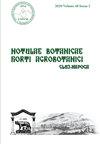硼毒性胁迫下接种丛枝菌根和植物生长促进根瘤菌对玉米(Zea mays L.)的影响
IF 1.3
4区 生物学
Q3 PLANT SCIENCES
引用次数: 0
摘要
一项温室研究调查了在硼浓度过高的情况下,丛枝菌根真菌和植物生长促进根瘤菌对玉米(Zea mays L.)产量和硼(B)吸收的影响。研究采用了四种硼浓度(0、10、20 和 40 mg kg-1 土壤)和四种微生物接种浓度(非接种、根瘤菌、云南小球菌和联合接种)。一般来说,硼的升高会降低玉米的相对产量、植株干重、株高、总叶面积和叶绿素含量。硼吸收量最高的是 20 毫克/千克-1 的硼处理,而吸收量最低的是 0 毫克/千克-1 和 40 毫克/千克-1 的硼处理。过量的硼供应会增加玉米叶片的脯氨酸含量和电解质渗漏。微生物接种不会改变硼胁迫植物的产量。此外,菌根接种和联合接种增加了芽和根对硼的吸收。与对照处理相比,无论是否接种微生物,在高浓度硼条件下生长的玉米植株都会出现叶片边缘烧焦和坏死现象。在硼胁迫条件下,微生物接种可提高玉米产量,最高可达 20 毫克硼 kg-1。因此,接种丛枝菌根和植物生长促进根瘤菌可以提高玉米对硼胁迫的耐受性。不过,当植物暴露于过量硼时,接种细菌和丛枝菌根有更大的缓解作用。本文章由计算机程序翻译,如有差异,请以英文原文为准。
The effect of arbuscular mycorrhizal inoculation and plant growth-promoting rhizobacteria on maize (Zea mays L.) under boron toxicity stress
A greenhouse study was conducted to investigate the effect of arbuscular mycorrhiza fungus and plant growth-promoting rhizobacteria on maize (Zea mays L.) yield and boron (B) uptake under excessive B concentrations. Four levels of B (0, 10, 20 and 40 mg kg-1 soil) and four levels of microbial inoculation (non-inoculation, Rhizophagus intraradices, Micrococcus yunnanensis and co-inoculation) were applied. In general, elevated B decreased the maize relative yield, plant dry weight, plant height, total leaf area and chlorophyll content. The highest B uptake was recorded in the 20 mg kg-1 B treatments, whereas the lowest uptake was in B treatments of 0 and 40 mg B kg-1. Excessive B supply increased the proline content and electrolyte leakage of maize leaves. Microbial inoculation did not change the yield of B-stressed plants. In addition, mycorrhiza inoculation and co-inoculation increased the shoot and root B uptake. Maize plants growing at high B concentrations with or without microbial inoculation showed leaf edge burning and necrosis when compared with control treatments. Microbial inoculation improved the maize yield under B stress up to 20 mg B kg-1. Thus, inoculation with arbuscular mycorrhiza and plant growth promoting rhizobacteria can increase the maize tolerance under B toxicity. Nonetheless, the inoculation of bacterium and arbuscular mycorrhiza had a more alleviative effect when the plants were exposed to excess B.
求助全文
通过发布文献求助,成功后即可免费获取论文全文。
去求助
来源期刊

Notulae Botanicae Horti Agrobotanici Cluj-napoca
PLANT SCIENCES-
CiteScore
2.70
自引率
0.00%
发文量
118
审稿时长
3 months
期刊介绍:
Notulae Botanicae Horti Agrobotanici Cluj-Napoca is a peer-reviewed biannual journal aimed at disseminating significant research and original papers, critical reviews and short reviews. The subjects refer on plant biodiversity, genetics and plant breeding, development of new methodologies that can be of interest to a wide audience of plant scientists in all areas of plant biology, agriculture, horticulture and forestry. The journal encourages authors to frame their research questions and discuss their results in terms of the major questions of plant sciences, thereby maximizing the impact and value of their research, and thus in favor of spreading their studies outcome. The papers must be of potential interest to a significant number of scientists and, if specific to a local situation, must be relevant to a wide body of knowledge in life sciences. Articles should make a significant contribution to the advancement of knowledge or toward a better understanding of existing biological and agricultural concepts. An international Editorial Board advises the journal. The total content of the journal may be used for educational, non-profit purposes without regard to copyright. The distribution of the material is encouraged with the condition that the authors and the source (Notulae Botanicae Horti Agrobotanici Cluj-Napoca or JCR abbrev. title Not Bot Horti Agrobo) are mentioned.
 求助内容:
求助内容: 应助结果提醒方式:
应助结果提醒方式:


